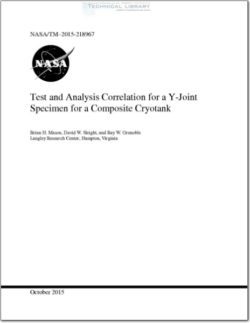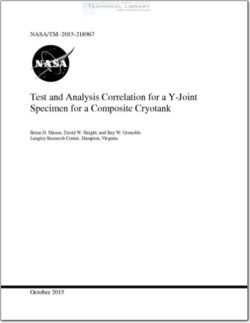NASA-TM-2015-218967

- Version
- 236 Downloads
- 1.86 MB File Size
- 1 File Count
- April 21, 2016 Create Date
- April 21, 2016 Last Updated
Test and Analysis Correlation for a Y-Joint Specimen for a Composite Cryotank

NASA is currently developing the next generation of launch vehicles to perform asteroid investigation and other
interplanetary missions. A crucial component of these missions is the use of lower weight advanced materials in
various structural components of the launch vehicles, including the liquid hydrogen (LH2) cryogenic tanks
(cryotanks). NASA’s Game Changing Development Program (GCDP) in the Space Technology Mission
Directorate (STMD) is tasked with maturing advanced space technologies that may lead to new approaches for
future space missions and transfer of these technologies to other government and industrial entities. The Composite
Cryotank Technology Demonstration (CCTD) Project was a part of the GCDP and was responsible for development
of space technologies utilizing advanced composite materials (see Refs. 1 and 2).
During 2012 and 2013, NASA and its industry partner, Boeing, participated in Phase II of the CCTD Project to
design, manufacture, and test a 2.4—m diameter precursor cryotank. In 2014, a 5.5-m diameter test article cryotank
was designed, manufactured, and tested based on lessons learned from the precursor cryotank. At present, testing of
the precursor tank is complete, and design and manufacturing of the 5.5—m cryotank has been completed. One of the
element-level test specimens developed for the precursor tank is a positive peel y-joint specimen, shown in Figure 1.
This specimen was developed because analyses from Phase I of the CCTD Project indicated that the y—joint region
had low margins of safety, and hence, the performance of this joint was critical to the cryotank design. Several y-
joint specimens were tested by Boeing in September 2012, but a detailed study of the failure modes of the specimens
could not be completed prior to testing of the precursor tank due to the project schedule.
The purpose of this paper is to correlate structural analysis models of the y—joint test specimens with the failure
modes and strains observed during test. Due to the very tight schedule of the CCTD Project, only coarse models of
the specimens were completed prior to the test. Stresses in the coarse model were obtained for the applied failure
load for use as design allowables for the tank, but the strains in the coarse model were never evaluated against the
test strain gage values. The detailed structural models of the y-joint were completed soon after the tests, but due to
schedule issues, they could not be adjusted to correlate with the strain gage data until after the tests on the precursor
tank were completed. In this paper, the process of correlating the detailed models with the composite delamination
failure mode observed during the y-joint specimen tests is discussed. This approach illustrates the issues associated
with proceeding to larger scale design and test without first understanding the failure modes of simpler element-
level specimens.
| File | Action |
|---|---|
| NASA-TM-2015-218967 Test and Analysis Correlation for a Y-Joint Specimen for a Composite Cryotank.pdf | Download |
Comment On This Post